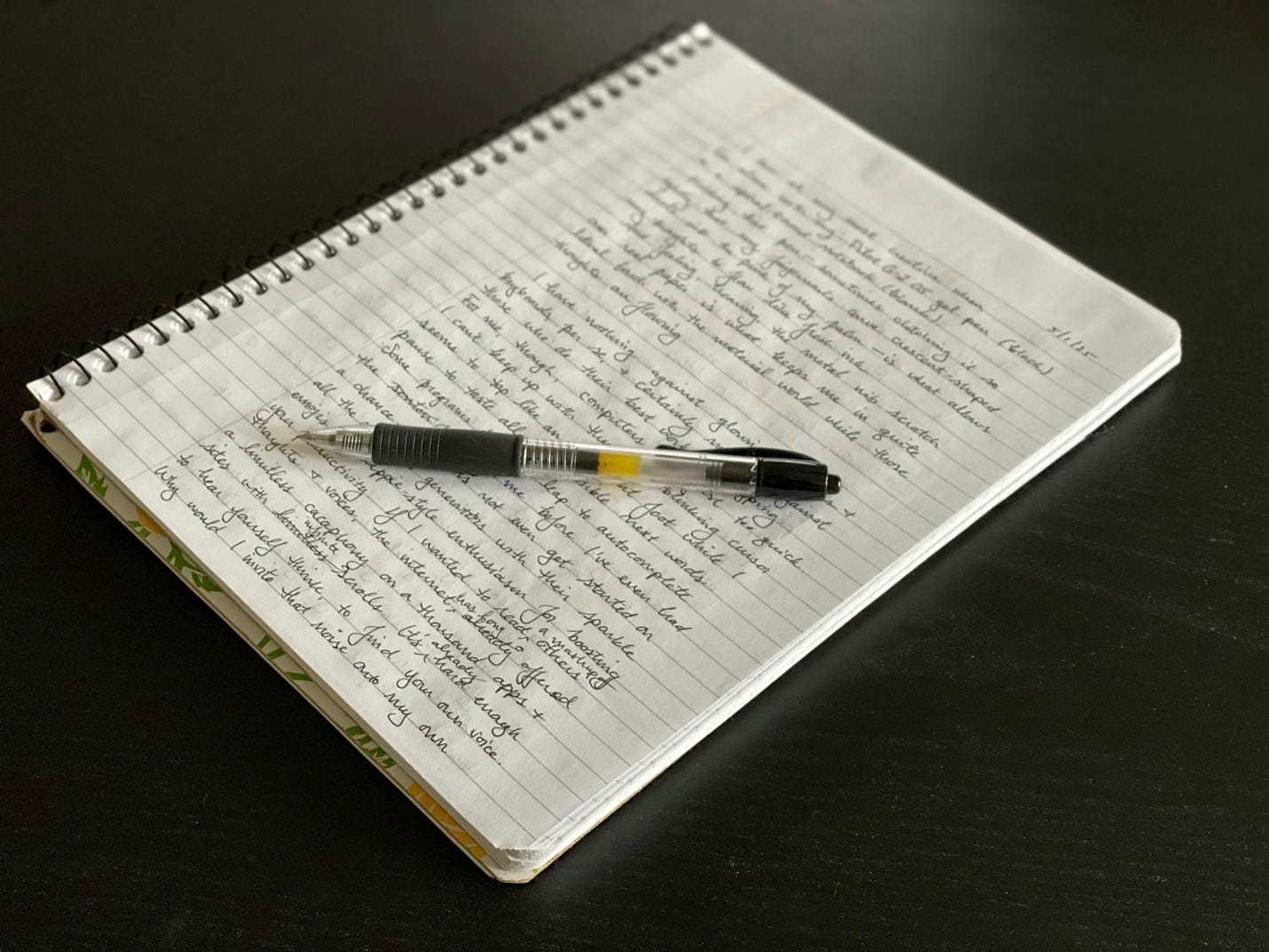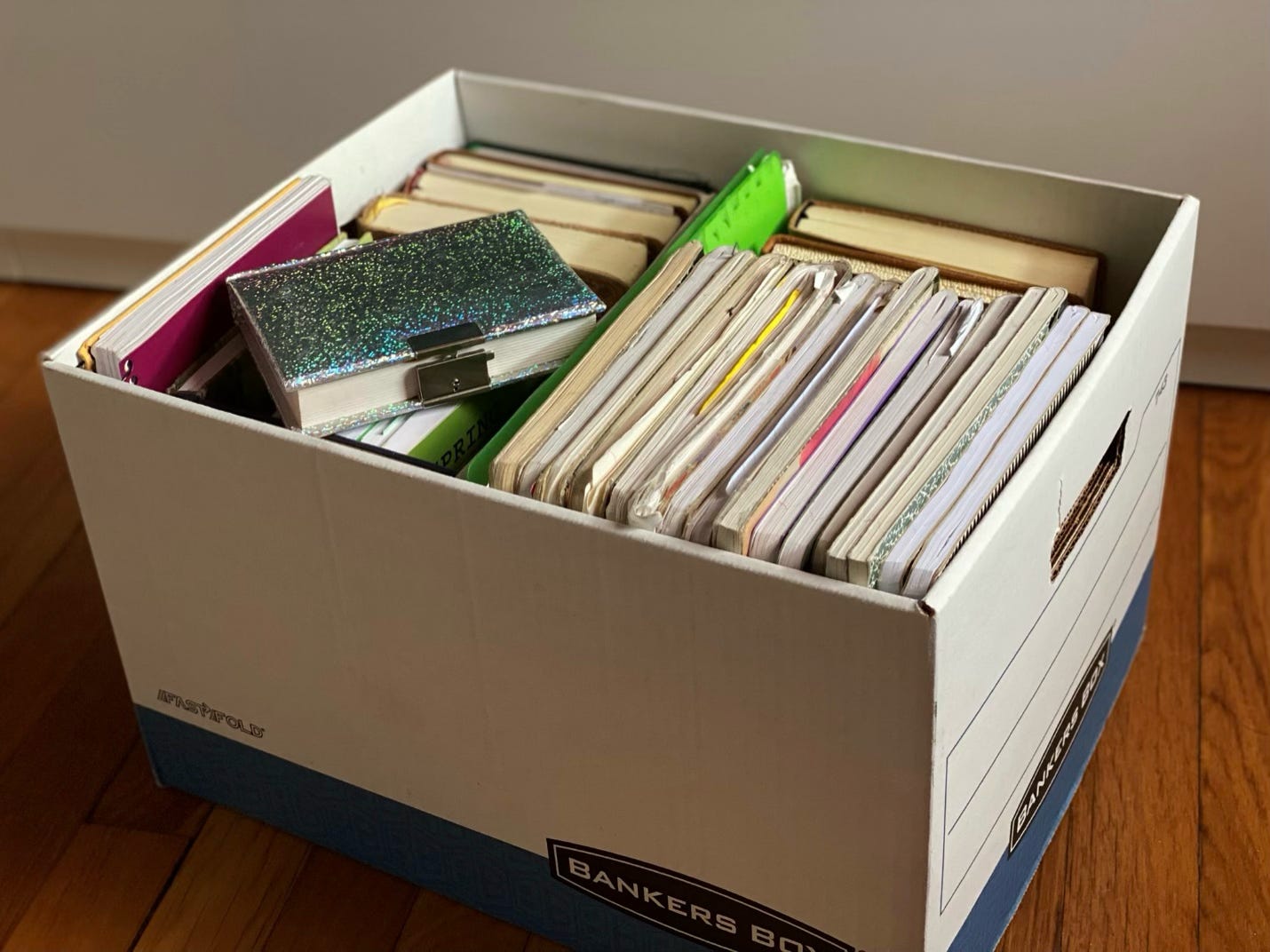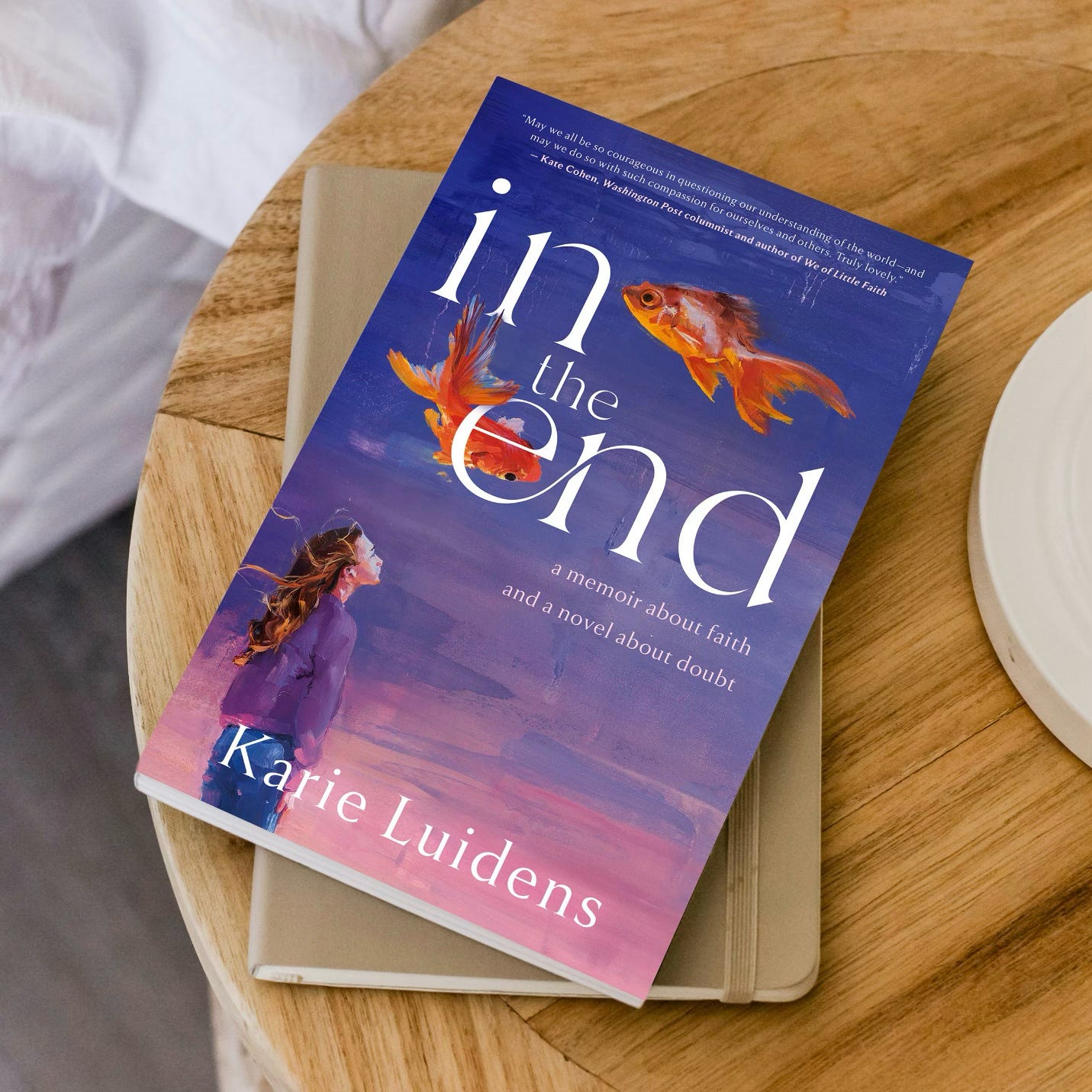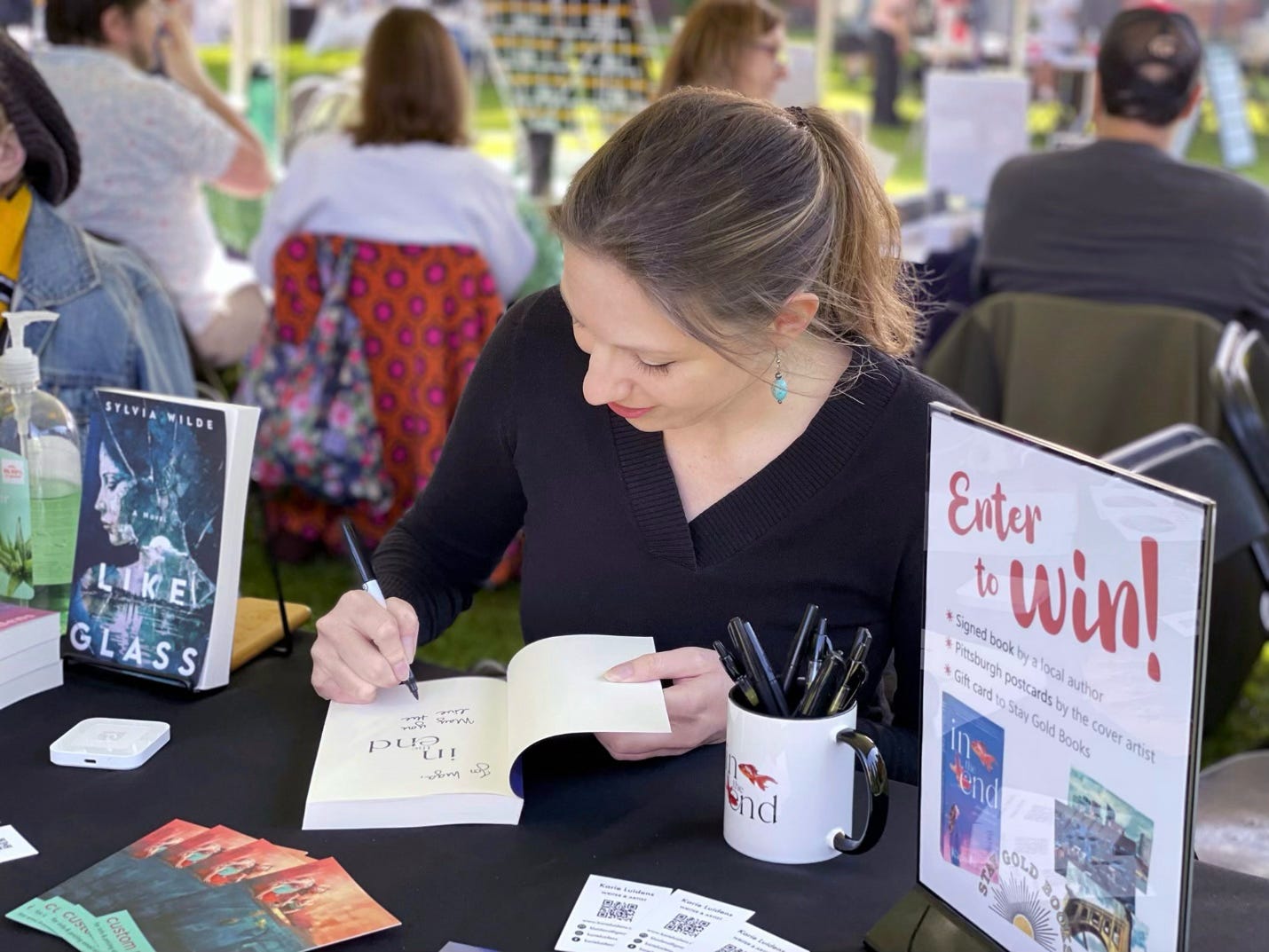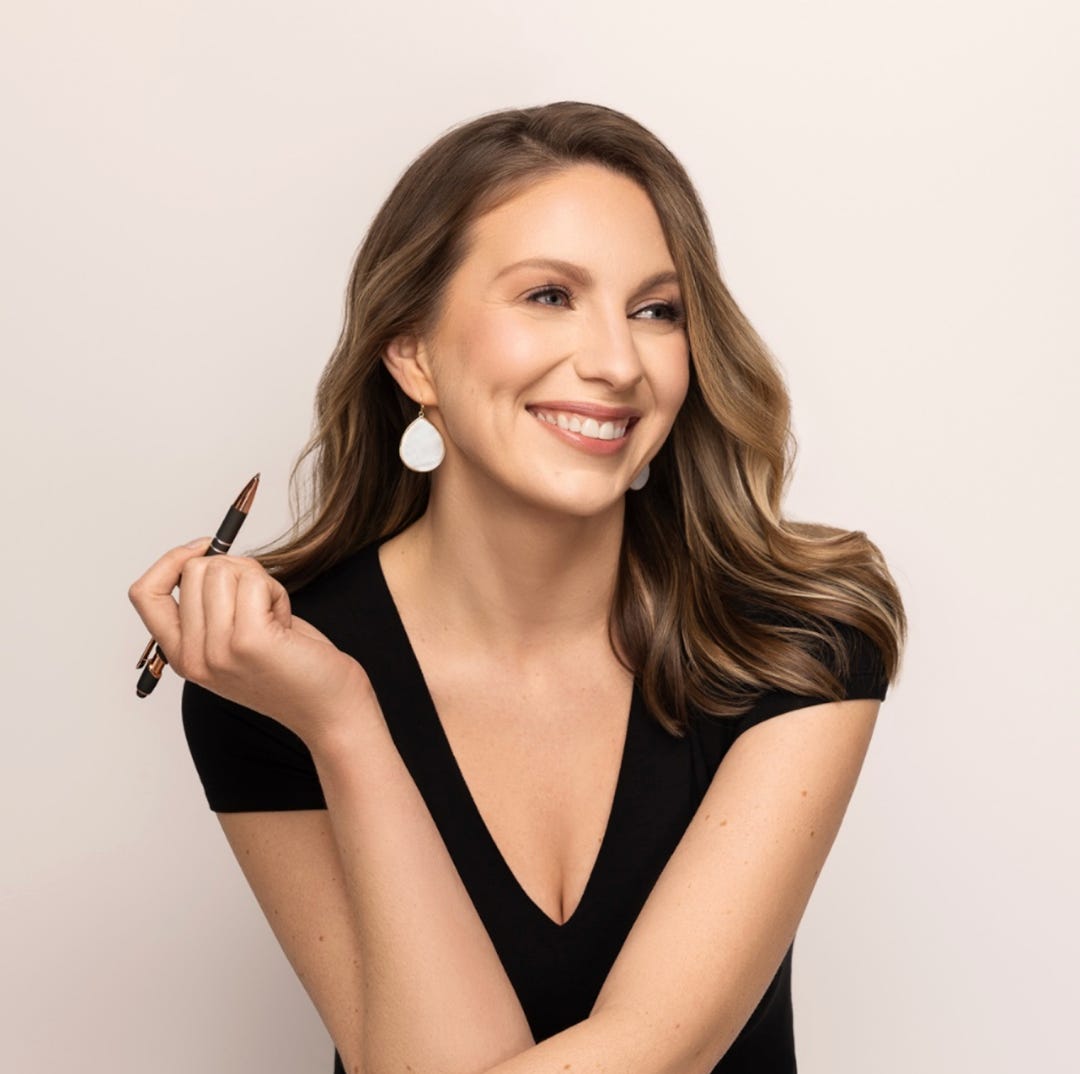This is a Fast Forward essay. This series zeroes in on one part of an artist’s Long Pause story: the getting unstuck part. Sometimes, looking back allows you to see all the small things you did that ultimately led you back to your creative practice— or towards a more sustainable one. If you know a creative person who has weathered a Long Pause (maybe it’s you!), you can reply to this e-mail to be in touch with me. Subscribe below so you never miss an interview! 👊
Hey there, welcome back. Today we’re hearing from Karie Luidens, another writer-artist hybrid, who exploded out of her Long Pause with a memoir! Incidentally, she has a studio across the hall from me at Radiant Hall, and I’ve seen her paintings (the Andy Warhol portrait is hanging in our common area!) which are worth a trip around her website. Enjoy! 💖 Erinn
by Karie Luidens
I am at my most creative when I’m alone with my Pilot G-2 05 pen (black) and a spiral-bound notebook (blank).
Holding that pen—sometimes clutching it so tightly that my fingernails leave crescents in the pink of my palm—is what allows my thoughts to flow like fresh ink.
And feeling & hearing the metal nib scratch over real paper is what keeps me in quite literal touch with the material world while those thoughts are flowing.
I have nothing against screens and keyboards per se, and certainly nothing against those who do their best work by typing. For me, though, computers are just too quick. I can’t keep up with them. The blinking cursor seems to tap like an impatient foot while I pause to taste the next word. Some programs leap to autocomplete the phrase for me before I’ve had a chance to consider it for myself. And let’s not even get started on all the new AI generators with their Clippy-style enthusiasm for productivity. If I wanted to read a mashup of others’ thoughts and voices, the internet has long offered a limitless cacophony with infinite scrolls. It’s already hard to hear yourself think, to find your own voice. Why would I invite that noise into my own writing practice?
That outside noise—that pressure to produce—just instills the sort of fear that stops my pen.
Growing up, I wrote constantly. My very first journal is a little disco-ball of a diary with No. 2 pencil scribbles about second grade. Things picked up in middle school with marble notebooks covered in magazine cutouts. At some point I transitioned to ballpoint and cursive. By the time I left for college, I had a whole shelf of these journals chronicling the anxieties of adolescent.
Now I keep them in a banker’s box in my bedroom, as closely guarded as a museum’s collection of prized artifacts. They tell a story, a history. They document the evolution of my views, my vocabulary, my voice.
But the archaeological record is incomplete: it stops abruptly in my senior year of college. It’s as if a volcano erupted and rained ash on my psyche until it was buried overnight, petrified.
Petrified is the perfect word here. (Would autocomplete or AI have suggested that, versus me thinking at the pace of my pen?)
pet·ri·fied /ˈpetrəˌfīd/adjective
so frightened that one is unable to move; terrified.
(of organic matter) changed into a stony substance.
And there it is. Creative thought flows like ink when I’m unhurried, unpressured. But faced with fear, it freezes into brittle stone.
If those years of journals are an archaeological record—layer upon sedimentary layer of paper through which one can dig—fear is the rock that clangs everything to a stop.
Why did I suddenly stop writing toward the end of college? Because, on the horizon, I saw it looming: the need to become a Serious Working Adult, an employee, a productive cog in some sector of a capitalist society. And I had no idea how to do that. Foolishly (I felt), all I’d studied was painting and language, none of which prepared me to find a full-time job, let alone perform it. All that mattered now was figuring out how I’d get insurance and pay rent.
I didn’t make a conscious choice to stop writing. But the more I fixated on formatting my thin resume, drafting desperate cover letters, clicking through job postings… the less creativity coursed through my veins. No one hired philosophers or poets. Pouring time into self-expression was a pointless waste.
So I stopped.
I spent the next five years plugging away in a call center.
And while I remember the anxiety and misery of those years, I have no written record of how it felt.
***
Ash is, at least, fertile soil for fresh growth.
After those fallow years defined by fear, I finally began to break free of the stony paralysis. It didn’t even take that much—just a fed-up thought of fuck it one fall day, followed by the purchase of several thick leather-bound journals, fancier than any I’d had before. I refused to let their heft intimidate me. I scrawled and scribbled with messy abandon, filling one after the other. I let tears drop to the paper and blur my words, then laughed at the melodrama of tear-soaked pages even as I continued to write and cry, write and cry.
I resolved that, whatever day job paid the bills going forward, I would not let it block the flow of my own thoughts on my own time. I would shake loose regularly to put pen to paper, not for a boss or customer or paycheck, but for my own sake. I would create; I would leave a record of my own existence.
Fifteen years after I abandoned personal writing to focus on surviving as a workaday adult, I published my first book. This week marks a year since it was released in 2024 by Left Field Publishers:
In the End: A Memoir about Faith and a Novel about Doubt
In three parts, this ever-more-fictionalized memoir recounts my coming of age from the earliest glimmer of consciousness in a warm home to the cold terror of comprehending how unknowable the cosmos are beyond.
I penned the first draft of this book midway through college, before my Long Pause.
It wasn’t until much later, after I broke through my block of fear and began writing again, that I was able to dig it out and complete the manuscript.
The book’s pages trace the first twenty years of my life. But when I hold a bound copy, I see also the fifteen years that followed: the fear that turned me to stone; the years of dried-up silence; the fight to let my words flow again; the ongoing rhythm of pauses and productivity ever since. The book’s existence proves that, no matter how unpredictable and uneven your private creative journey, it can culminate in something substantial, finished, and worth sharing with the world.
I don’t know what works for others, but for me the surest way to unfreeze is to return, over and over, to the physical materials of creation—in the case of writing, pen and page. Nothing instant or rushed, a click away from posting or hitting send. Just the quiet scritch of nib against paper, the sight of my own handwriting as it loops into existence. When the ink flows, my thoughts can flow with it. Then I follow the trickle for as long as I can.
Since I write by hand with my Pilot G-2 05, the first step toward actually sharing my words is to type them up. If you’re reading this now, you’ll see straight lines of text in a standard font, glowing on your screen. But as I draft, I see how it’s first inked: half-legible, littered with cross-outs and carets inserting synonyms. And, to avoid the petrifying effect of fear, that’s all I let myself see—my own cramped cursive, safe in private notebooks, never to be judged by others.
Even when I know the opposite to be true: that I am, ultimately, writing this for a reader.
Dear reader, if I have any advice regarding your own creativity, it is to acknowledge the power of fear, and to practice facing it. If and when it petrifies you, learn to say fuck it. Get yourself a big blank journal. Write and cry, write and cry, until you find yourself flowing along with the ink. Then keep doing that with me, over and over, for the rest of our creative lives.
Karie Luidens is an award-winning writer and artist with roots in upstate New York and West Michigan. Her personal and political essays have been featured everywhere from niche literary magazines to international news outlets, and her paintings have hung in juried exhibitions across multiple cities. She has also served as an arts and culture reporter for several regional publications in New Mexico. 2024 marked the publication of her first book, In the End: A Memoir about Faith and a Novel about Doubt. She currently lives in Pennsylvania, where she maintains an active creative practice.
Find more of her writing and art: karieluidens.com
Follow her on Instagram: @karieluidens




